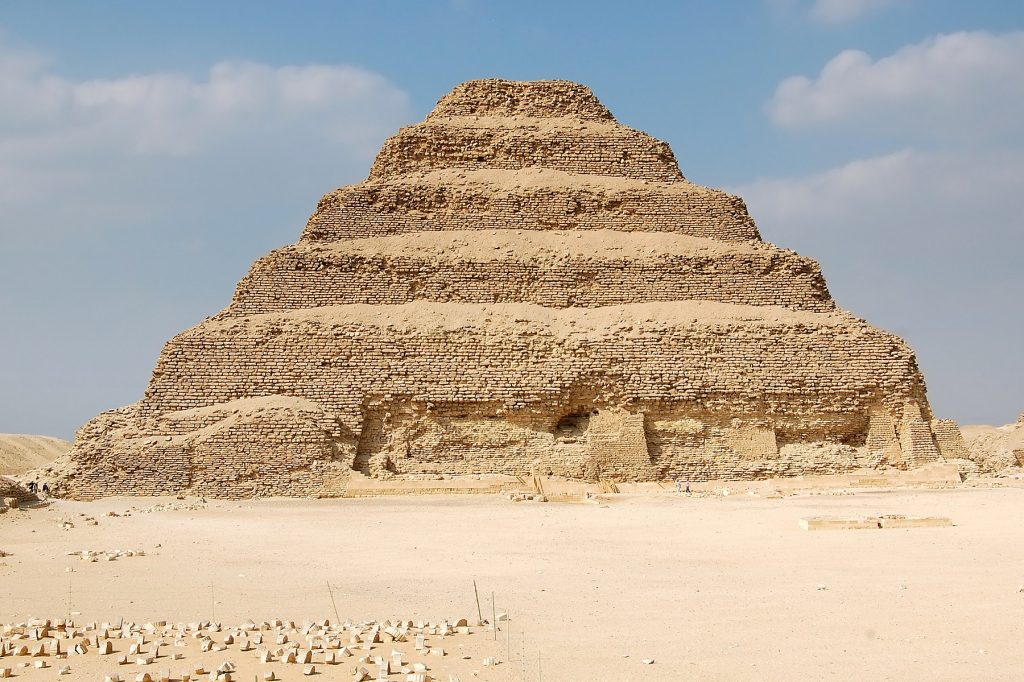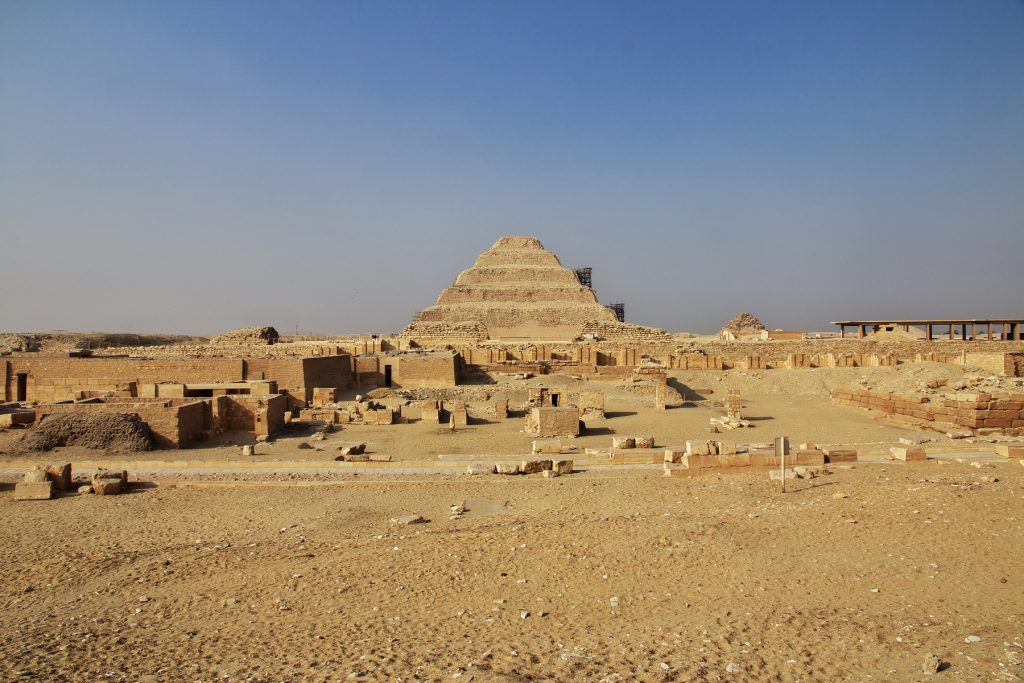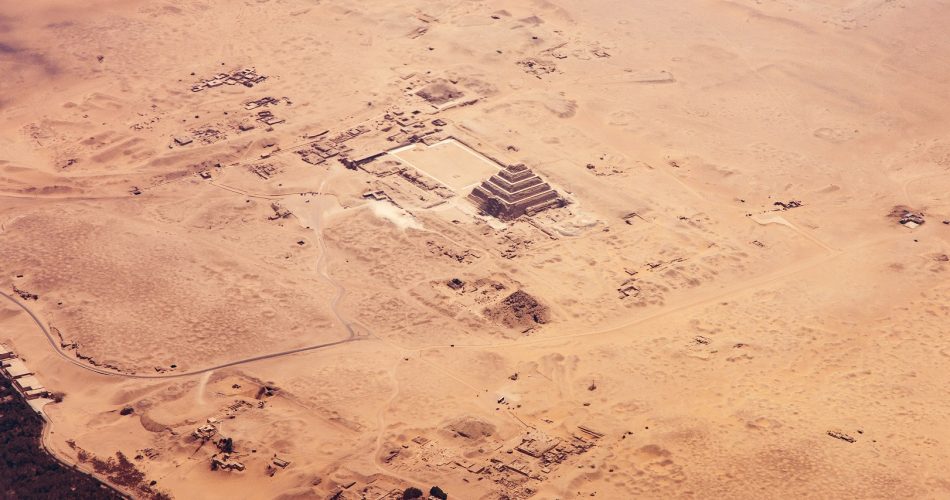- Regarded as the oldest pyramid ever built in Egypt, the Step Pyramid of Djoser was a monument that revolutionized ancient Egyptian architecture.
- Beneath the pyramid is a massive subterranean world spanning more than 5.7 kilometers in length.
- With a total volume of 330,400 cubic meters (11,667,966 cu ft), the construction of the Step pyramid and its pyramid complex was an unpreceded construction project of immense scale in ancient Egypt.
- The Step Pyramid of Djoser is thought to be the architectural evolution of ancient Egyptian Mastabas.
Many generations before Pharaoh Khufu came to the throne during ancient Egypt’s Fourth Dynasty, great Kings revolutionized Egypt in more ways than one. The oldest pyramid in Egypt, the Step Pyramid of Djoser, was the first of its kind in Egypt.
Officially speaking, the Pyramid Age in Egypt began an entire Dynasty before Khufu and Giza’s “Great Pyramids.” In fact, the very foundations for the construction of the Great Pyramid of Giza–Egypt’s most famed pyramid–can be traced back to a King that predates even Khufu’s father.
Djoser and the first pyramid
Around 2,700 BC Pharaoh Djoser reigned over Egypt and it was during his rule that architecture and engineering were revolutionized forever leaving an imprint in the Egyptian civilization. Abruptly, unexpectedly, and perhaps unintentionally in some ways, Egypt’s First Pyramid–The Step Pyramid of Saqqara–became the first ancient wonder constructed in the land of the Pharaohs.
Although the Step Pyramid of Djoser was not the Pharaoh’s first monument–having built a mastaba previously–for reasons that remain unclear, he turned to his royal vizier and architect Imhotep and instructed him to erect a monument like no other. Imhotep, as a young architect with revolutionary ideas, did not disappoint. Djoser recognized the young man’s talent and gave him free hands in erecting the monument at Saqqara.
It can be concluded, without a reason of a doubt, that few monuments on Earth hold a place in human history as significant as that of the Step Pyramid in Saqqara. The enigmatic monument, together with the structures that were built surrounding it compose the Pyramid complex of Djoser. As noted by famed Egyptologist Miroslav Verner, it can be said, without exaggeration, that the Step Pyramid complex of Djoser constitutes a milestone in the evolution of monumental stone architecture in Egypt, and the entire world as a whole.
It is precisely at Saqqara where Limestone was first used on a large scale as construction material, and it was at Saqqara where the idea of a monument royal complex, with the pyramid as the central form, was first accomplished. Therefore, it can be said that King Djoser can be seen as the inventor of stone architecture.
The Step Pyramid was a gigantic accomplishment in ancient Egyptian architecture. Majestic, imposing with its central monument the Step Pyramid actin almost as a stairway to the cosmos, the architectural importance of the pyramid was not the only notorious characteristic. Compared with Predynastic and Early Dynastic Periods, Djoser’s Pyramid complex also reflects a different mentality in ancient Egypt.
The Pyramid complex of Djoser is regarded by many scholars as the expression of Egyptian political stability at the very start of the old Kingdom.
Nonetheless, some Egyptologists maintain that despite the massive influence the Step Pyramid of Giza had in history, the builders copied earlier architectonic elements in stone. Limestone walls with niches imitate earlier structures made of wooden planks, along with ropes and poles hung with mats. Stone pillars represent massive pyramids rushes, and within stone portals were wide-flung stone doors.

Exploring the oldest Egyptian pyramid
Although Djoser’s Step Pyramid is considered the oldest in Egypt, an archaeological study on the Djoser complex, as well as many other ancient Egyptians sides did not begin until Napoleon’s Egyptian campaign at the turn of the 19th century.
Not long after, in 1821, Prussian General Johann Heinrich Freiherr von Minutoli fond access that leads towards the subterranean world beneath the Pyramid. However, it wasn’t until 1837 when Egyptian Egyptologist John Perring discovered the extension of the subterranean world beneath the pyramid, with its many galleries and chambers, and as many as thirty ancient mummies that–curiously–belonged to a period predating that of Djoser.
Minutoli described his discoveries in Reise Zum Tempel des Jupiter Ammon, which various excellent drawings made by Italian artist Valeriani.
The most extensive and notorious archaeological work at the site as conducted in the 1920s when English researcher Cecil Firth visited Saqqara. He was also joined by French architect Jean-Philippe Lauer, whose life-long work revealed many important details about the pyramid and its temples. In fact, Egyptology, in general, owes to Jean-Philippe Lauer the current knowledge of the Pyramid complex and its surrounding structures.
The Step Pyramid revealed
The Great Trench. One of the more peculiar characteristics of the Step Pyramid of Djoser is the so-called Great Trench. The Pyramid Complex was not only surrounded by a massive, never-before-seen perimeter wall of limestone, but it was entirely surrounded by a massive trench that lay beyond it. This massive feature of the pyramid was originally dug into the underlying rock and despite the fact that it has long since been filled up with sand, it is still recognizable in today’s satellite images of Saqqara.
The trench measures 740 meters long and is approximately 40 meters wide. According to researchers, it is the largest structure of its type in the Memphis necropolis. The great Trench is oriented north and south.
According to Egyptologist Dr. Kamil O. Kuraszkiewicz, the massive trench was a three-dimensional model of the deceased pharaoh’s way to the afterlife.

Another fascinating feature was the Perimeter Wall. Modeled on woven mats, the perimeter wall of the pyramid complex was decorated with niches and fifteen unequally distributed doors of which only one, in the east facade, is the true entrance. The wall was built out of light Tura limestone and measured 10.5 meters high. The wall design recalls the appearance of 1st Dynasty tombs, suggest Egyptologists.
Although the entire pyramid complex includes numerous specific design elements such as the Entrance Colonnade, the South Courtyard, or the Southern Tomb, in this article we’ll focus on the Step Pyramid itself.
The Step Pyramid, the monument which dominates the entire complex, is one of the most unique ancient structures of ancient Egypt. Studying the pyramid has produced as many questions as answers. Analysis of the pyramid has brought forward evidence that suggests the pyramid, like many other ancient pyramids around the world, was changed and constructed in various phases.
Therefore, we can conclude that the current shape and form of the pyramid is, in fact, the result of a long process of development that includes not only experimental elements, but also improvised ones.
Egyptologists agree that the structure had the form of a square mastaba during initial constructions. This stage is dubbed M1. The pyramid–initial morphed mastaba–was gradually enlarged, first on all four sides (stage M2) and then only to the eastern side of the structure (stage M3). By the M3 stage, the structure already had a kid of Stepped mastaba shape.
However, the architect of the pyramid decided to further expand the structure and experimented with the monument.
The step-shaped mastaba was rebuilt in two stages, first as a four-step (p1 stage) and then as a six-step (p2 stage) pyramid which no longer had a square base, but a rectangular one, and was oriented east-west.
The exact reason behind the choice of building a pyramid tomb has remained obscured throughout history. The Step pyramid is believed to draw ideas from various precedents, the most relevant of which is found not far from where the Step Pyramid Stands.
Mastaba 3088 at Saqqara is believed to have influenced the shape and construction of the Step Pyramid in more ways than one.
The ancient Mastaba’s substructure was built into a rectangular pit and had mudbrick walls rising to a height of around six meters. Three sides of the monument were extended and built to create eight shallow steps that rose towards the sky at an angle of 49 degrees. The monument would have been a very steep Step Pyramid had the builders not left one of the sides exposed.
The Czech astronomer Ladisalv Krivsky believed that the builders of Djoser’s pyramid were inspired by the form of the rising and setting Sun, which from time to time and under specific physical and atmospheric conditions, would produce a form that gives the Sun’s disk the form of a stepped pyramid.

I firmly agree with this notion for the construction of the Step Pyramid, however, I believe the builders were influenced not only by the stepped shape the Sun would embrace but also by the fact that the Step Pyramid can be regarded as a massive stairway towards the Sky.
The pyramid would, therefore, have expressed the idea, connected to the ancient Egyptian worship of the sun, that the king in his Step-Shaped (tomb?) monument is as immortal as the sun.
Furthermore, the sudden appearance of the pyramid shape during the Third dynasty can also be regarded as a physical representation of the primeval mound that appeared from the original flood when the Earth was created.
Various theories regarding the construction of the pyramid, and the original mastaba M1 have appeared throughout the years.
However, and since there are no written accounts of the construction process of the Step Pyramid, it is nearly impossible to fully understand the reasons behind the construction of such a monument, and what exactly it signified to the ancient Egyptians more than 4,700 years ago.
In its final form, the completed Step Pyramid is believed to have measured around 140 meters from east to west and approximately 118 meters from north to south. the pyramid stood 62.5 meters high. The total volume of the Step Pyramid of Djoser is 330,400 cubic meters (11,667,966 cu ft).
Just as the pyramid itself was revolutionary and imposing, what lies beneath it is beyond fascinating.
Beneath the Step Pyramid, the builders somehow managed to create an underground structure on a scale that has previously never been seen in history: they somehow managed to quarry out more than 5.7 kilometers of shafts, tunnels, chambers, magazines as well as galleries, creating a behemoth underground world.
A central corridor, as well as two paralleled, once extend covering a distance of more than 365 meters and connect around 400 subterranean rooms. These and other underground features surround one of the most complicated tangles of tunnels, shafts, and corridors the ancient Egyptians ever created below the pyramid.
How exactly this was achieved and why the builders saw a necessity to build such a vast underground complex more than 4,700 years ago remains a profound mystery, modern experts have been unable to answer.
This unique feature would never again be repeated in any of the pyramids that were built–or attempted to be built–after Djoser.
One would expect that the Step pyramid complex and its elements would endure for a long time after. However, although a few Pharaohs after Djoser attempted in replicating the Step Pyramid and its pyramid complex, Egypt would not see another completed pyramid until Fourth Dynasty Pharaoh Sneferu came to the throne during ancient Egypt’s Fourth Dynasty when he built the Pyramid at Meidum.

